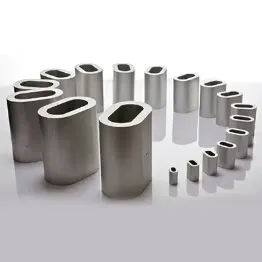Новини
Гру . 02, 2024 15:17 Повернутися до списку
How to Inspect and Maintain Wire Rope Fittings for Optimal Performance
Wire rope fittings are integral components in lifting and rigging systems, ensuring secure connections between wire ropes and other equipment. These fittings—such as clips, shackles, thimbles, and swage fittings—play a vital role in transferring loads safely and efficiently. Regular inspection and maintenance of wire rope fittings are essential to ensure their continued performance, prevent accidents, and extend the lifespan of both the fittings and the wire rope. Neglecting proper care can lead to equipment failure, downtime, and potentially dangerous situations. This article outlines how to inspect and maintain wire rope fittings for optimal performance, emphasizing safety, longevity, and efficiency.

The Importance of Regular Inspection About Фітинги для тросу
Rope end fittings, though durable, are subjected to extreme forces, wear, and environmental conditions. Over time, these conditions can cause the fittings to degrade, leading to potential failures. Regular inspection is the first step in identifying issues before they escalate. Inspections should be conducted periodically, depending on the frequency of use, load capacity, and operating conditions. It is especially important to inspect fittings after heavy lifting operations, adverse weather conditions, or when the wire rope system shows signs of wear or damage.
The purpose of inspection is to detect any visible signs of damage such as cracks, corrosion, wear, or deformation. Even slight damage can compromise the integrity of the wire rope fitting, which may result in system failure under load. Early detection and maintenance allow for timely replacement or repair, helping prevent accidents and extend the lifespan of both the fittings and the wire rope.
Identifying Common Signs of Wear and Tear About Фітинги для тросу
There are several key indicators that a steel rope fittings may need attention. The first sign to look for is visible corrosion or rust, particularly in marine or outdoor environments where fittings are exposed to moisture or chemicals. Corrosion weakens the metal, reducing its load-bearing capacity and making it more prone to failure. Wire rope fittings should be checked for any rust or signs of pitting, which may indicate internal corrosion.
Cracks or fractures on the surface of the fitting are another critical sign of wear. Even small cracks can quickly worsen under tension, leading to catastrophic failure. Inspect areas of the fitting that are subjected to the most stress, such as the load-bearing points and connection areas.
Deformation is also a common issue in wire rope fittings. Over-tightening, excessive loads, or incorrect installation can cause fittings to become bent or distorted. Fittings that are no longer in their original shape will not function as intended and can cause uneven load distribution, leading to instability or further damage.
Lastly, look for signs of excessive wear on the wire rope itself, as this can impact the performance of the fittings. Worn-out rope can fray, lose strength, or develop kinks, which will stress the fittings and reduce their effectiveness.
Practices for Wire Rope Fitting Maintenance
Maintaining wire rope fittings is just as important as inspecting them. Regular maintenance ensures that the fittings continue to perform at their best and last longer. Proper care can also prevent unnecessary wear and tear, saving both time and money on replacements.
To begin with, cleanliness is essential. Wire rope fittings should be kept free from dirt, debris, and grease. Accumulation of grime can lead to premature wear by increasing friction or preventing the fitting from engaging correctly with the rope. Cleaning fittings regularly with a soft brush and mild detergent, followed by thorough drying, can help maintain their condition. For fittings exposed to harsh chemicals or seawater, use specialized cleaning agents designed to remove corrosion and prevent further damage.
Lubrication is another key aspect of fitting maintenance. Some types of wire rope fittings, such as clips and shackles, require regular lubrication to ensure smooth operation and prevent corrosion. Use a high-quality lubricant that is suitable for the material and operating conditions. Over-lubricating can attract dust and dirt, so it is important to apply lubricant sparingly and wipe off any excess. Be sure to check the manufacturer’s guidelines for recommended lubrication practices.
Regular tightening and adjustment are also important. Over time, the tension on wire rope fittings may loosen due to stress from lifting operations. Always check that bolts, nuts, and other fasteners are properly tightened and that the fitting is securely attached to the wire rope. However, avoid overtightening, as this can cause damage to both the fittings and the wire rope.
Replacing Worn or Damaged Wire Rope Fittings
Despite proper inspection and maintenance, wire rope fittings will eventually wear out or become damaged beyond repair. When this happens, the damaged fitting must be replaced immediately to prevent compromising the safety of the rigging system. It’s important to always use the correct replacement fitting, ensuring that it is compatible with the wire rope and designed for the specific load requirements. Never reuse a fitting that has been damaged, even if it appears to be functional at a glance.
When replacing fittings, ensure that the new components are installed according to manufacturer instructions. Proper installation is crucial to avoid damaging the rope or compromising the entire rigging system. Be mindful of factors such as load capacity, fitting size, and alignment. Installing the wrong type of fitting can cause uneven load distribution, which can lead to failure during use.
-
Small components of lifting ring nuts with large load-bearing capacity
НовиниNov.24,2025
-
Flower basket bolts inject stable strength into your project
НовиниNov.18,2025
-
Although the lifting ring is small, its function is enormous
НовиниNov.12,2025
-
Lifting shackle: The indispensable "safety connecting ring" in lifting operations
НовиниNov.05,2025
-
Full analysis of lifting chain technology and application standards
НовиниOct.31,2025
-
Card head usage guide
НовиниOct.28,2025
